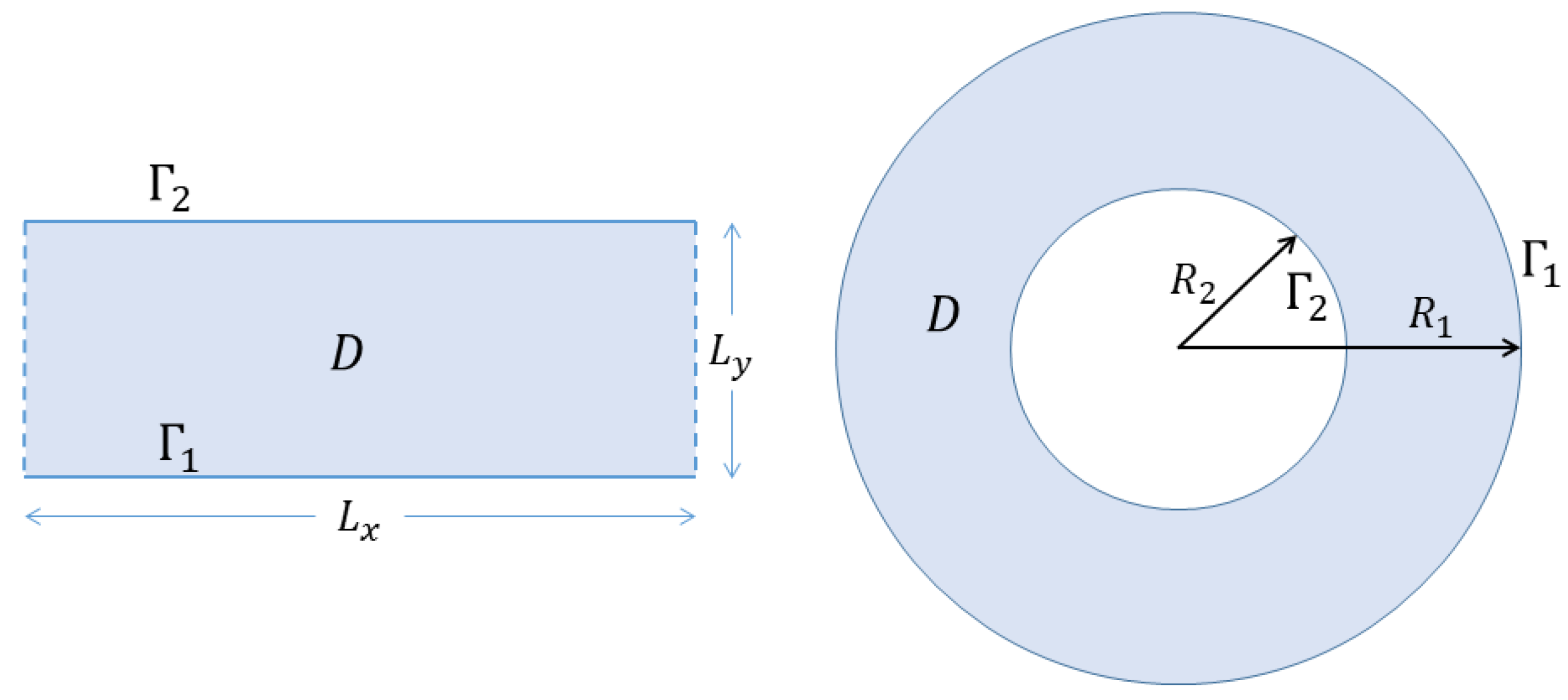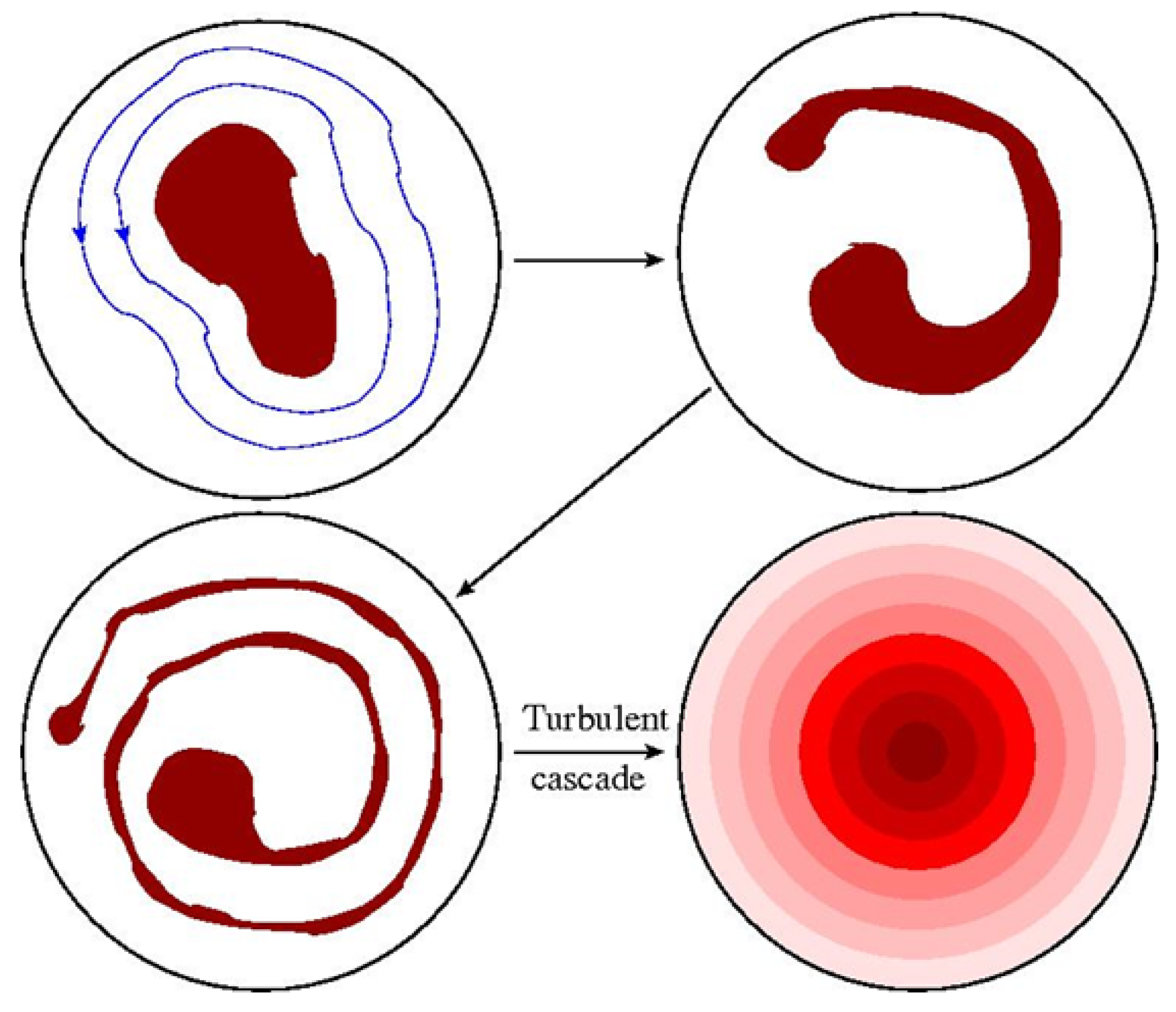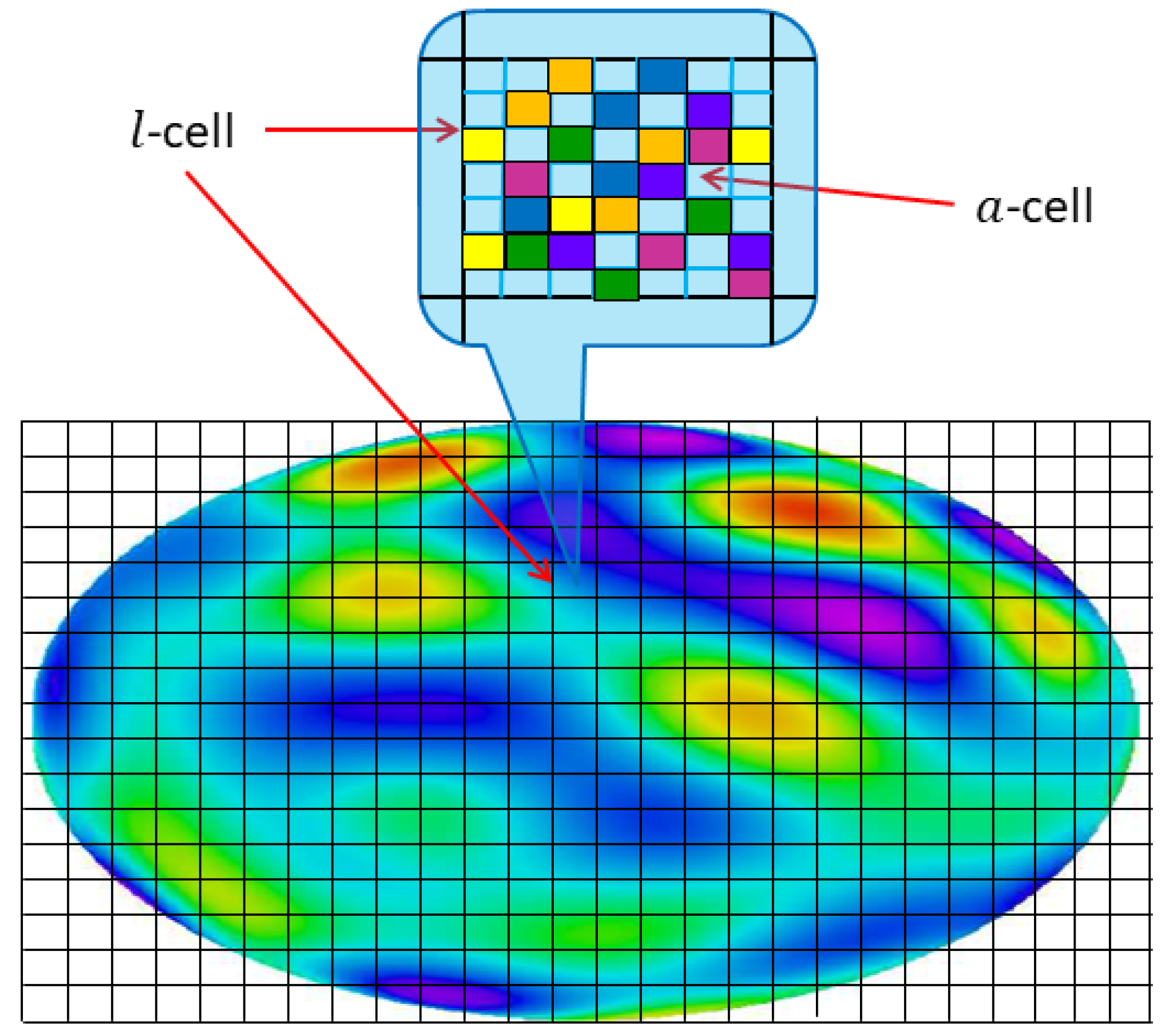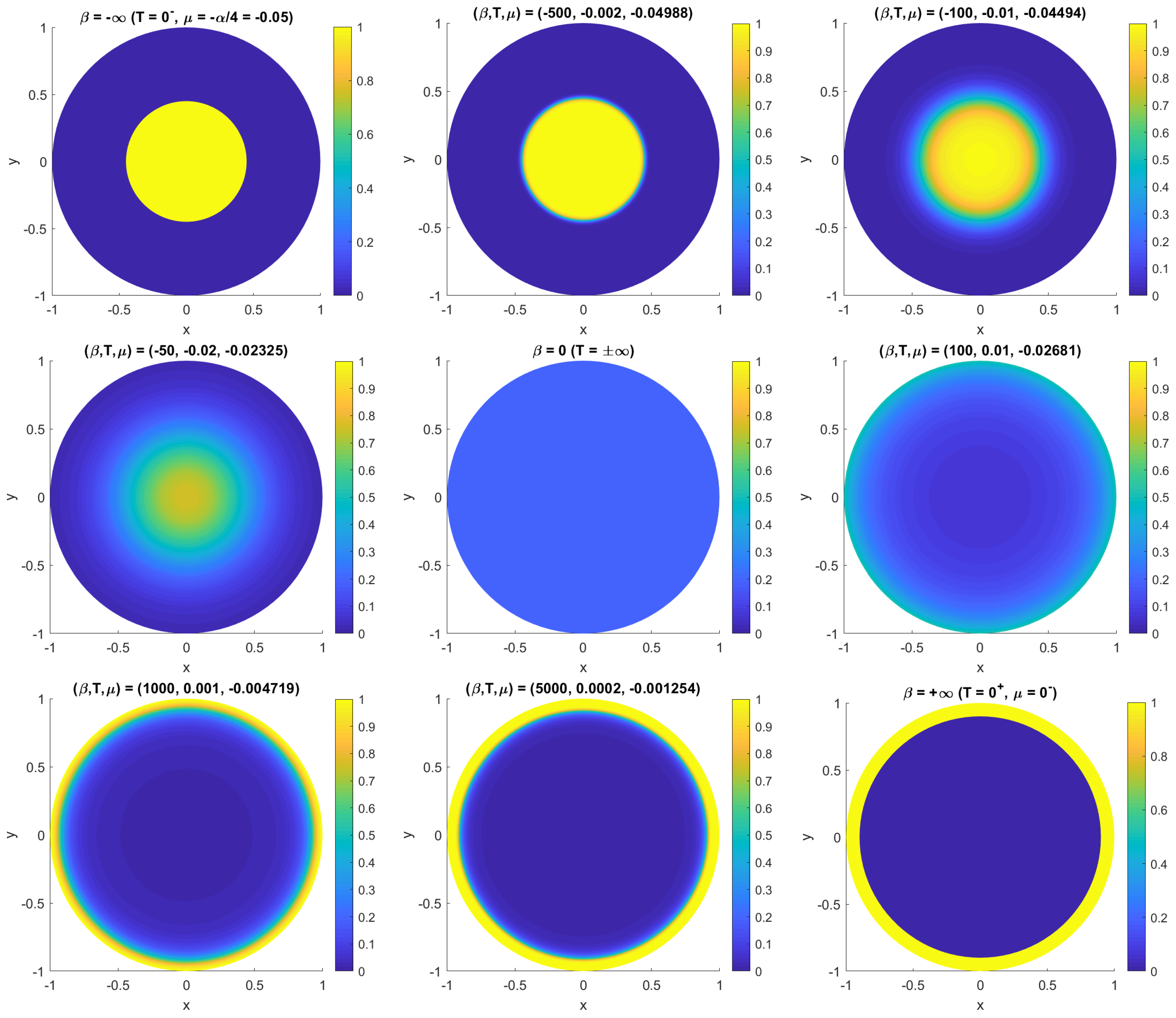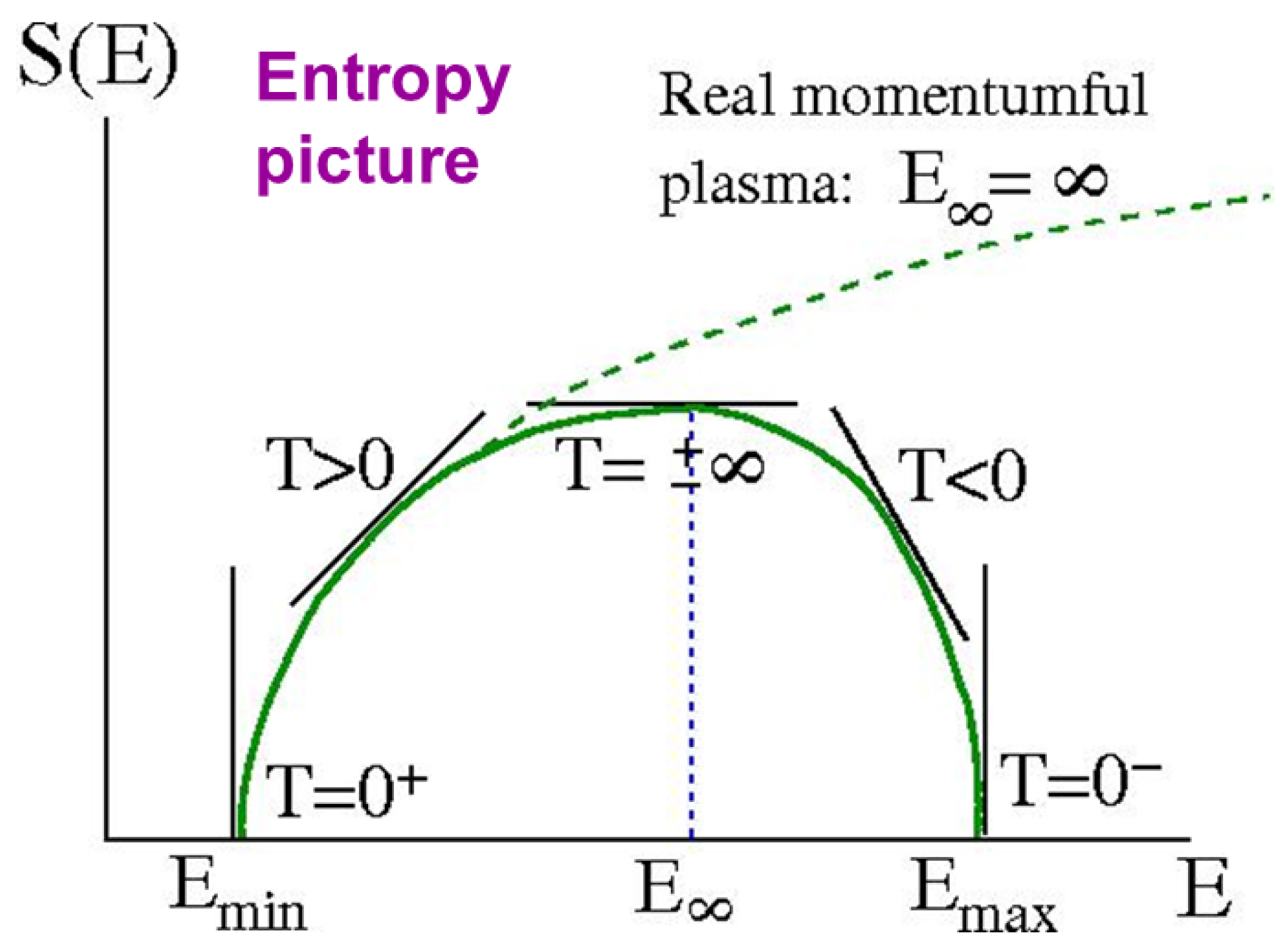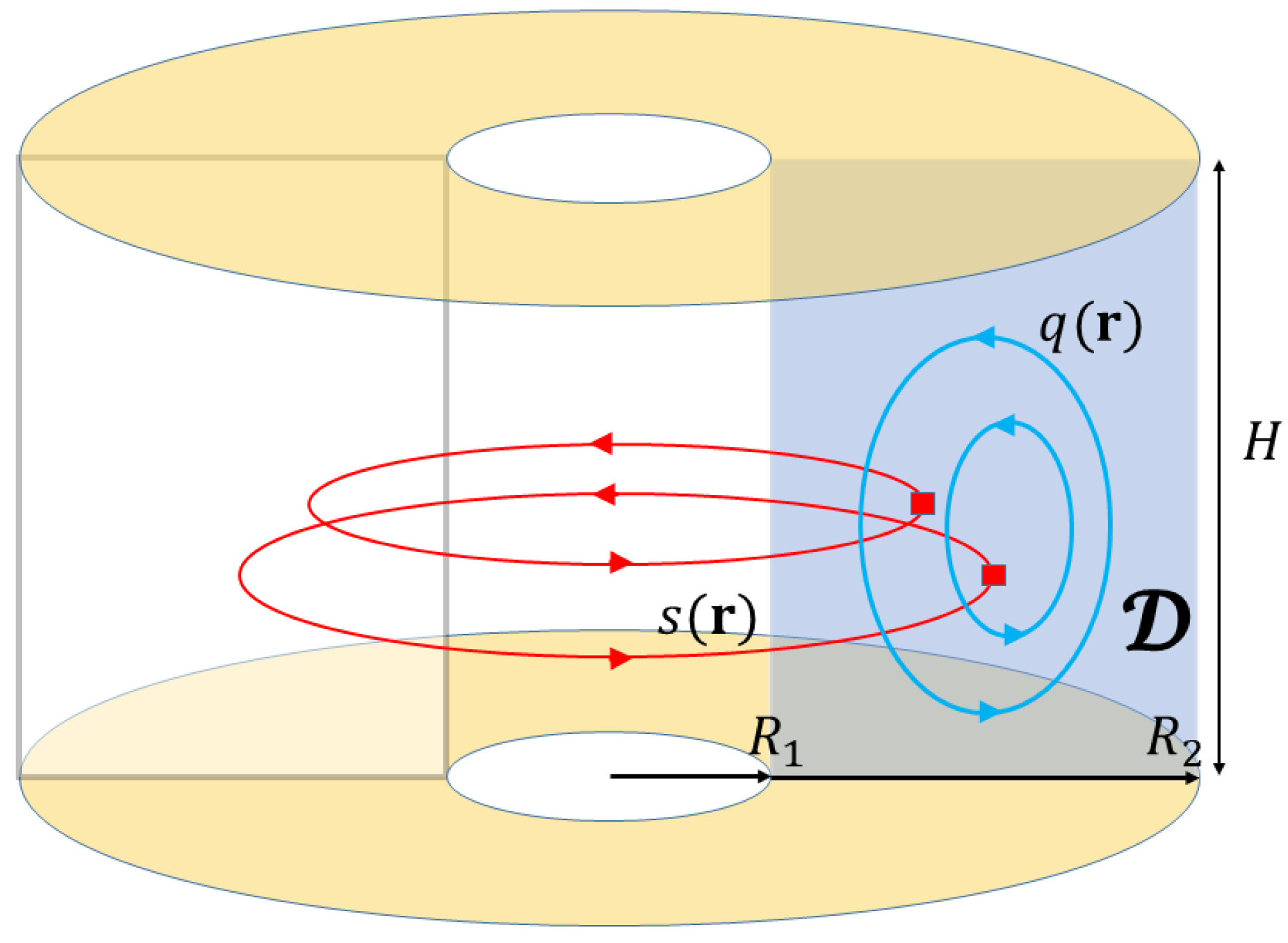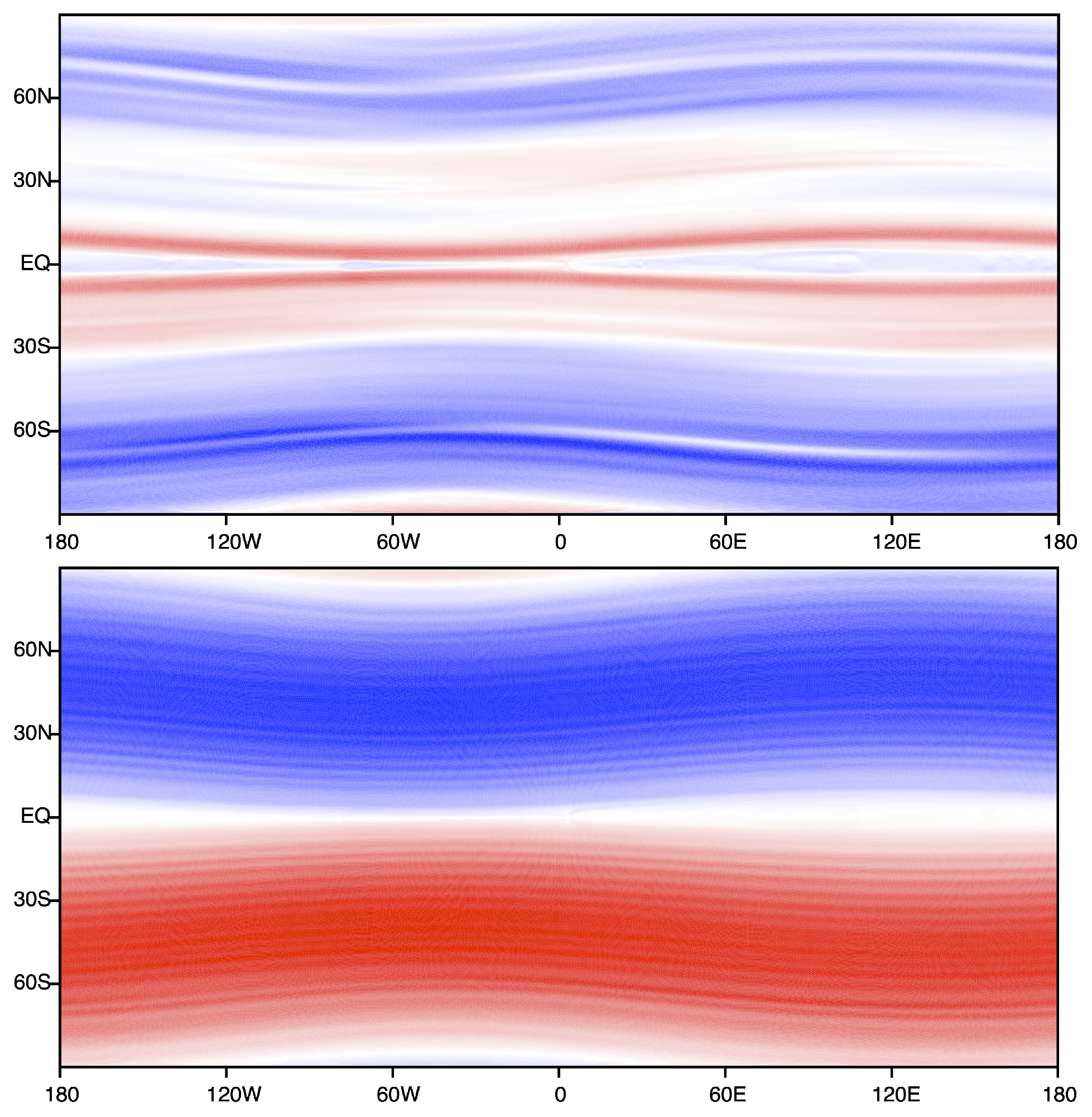1. Introduction
Remarkable progress has been made over the past 30 years or so applying rigorous statistical equilibrium principles to classical fluid systems with increasing degrees of complexity [
1]. The essential idea is that a freely decaying, strongly turbulent initial condition at late time is often observed to relax into a macroscopically smooth steady state (illustrated below in Figure 3). These ideas are especially interesting in two dimensions where
inverse cascades can generate nontrivial macroscopic features, such as system-spanning eddies or jets, from purely small scale, but significantly nonlinear fluctuations. Moreover, additional strong constraints, that forbid 2D eddies from “turning over” and effectively self-canceling, lead to an infinite number of additional conserved integrals of the motion, known as Casimirs. Acting together, all of these lead to a similarly infinite number of possible late-time flow geometries. These are exemplified, e.g., by Jupiter’s Great Red Spot, gas giant latitudinal band structure, polar vortices [
2,
3,
4], and other planetary flows.
Some, but by no means all, of these near-steady state long-lived, structures might be considered as weakly driven, balanced by weak dissipation. It then becomes interesting to seek quantitative and qualitative insights using models in an idealized zero driving, zero dissipation limit. For realistic comparisons, these models may additionally require nontrivial multilayer vertical structure. Here we consider only the simplest models with the fewest number of degrees of freedom exhibiting various fundamental physical phenomena. These ideas have a very long history [
5,
6,
7,
8,
9,
10] but notable progress was made in the early 1990s [
11,
12,
13,
14], motivated in part by then recent numerical simulation results [
15,
16], accounting for the full set of Casimirs in place of, e.g., point vortex and energy–enstrophy (Gaussian model) approximations. The early Ref. [
10] is especially notable because it derives a theory of galaxy dynamics (based on the Boltzmann equation) that is mathematically equivalent to the 1990s fluid dynamics work, but was not recognized as such until much later [
13,
17,
18].
From a mathematical point of view, the statistical mechanics of fluid motions ultimately reduces to study of certain classical field theories, especially involving the velocity field and fields derived from it. Some of these theories bear resemblance to those describing more conventional systems, such as Ising spin models and fluctuating elastic membranes. However, the most interesting fluid behaviors, especially those pertaining to large scale flows, tend to correspond to unusual limits of these models that have not been previously explored.
Table 1 provides a summary of these field theories that will be explained in much greater detail in later sections.
Predictions for the late time equilibrium state, assuming that it is reached, are based only on certain macroscopic features of the initial condition, namely the values of the conserved integrals, including total energy, linear or angular momentum, and the Casimirs. Although insensitive to the details of the turbulent decay that gives rise to these states, such predictions, beyond their intrinsic interest, could provide useful consistency checks on results from late time direct numerical simulations. Conversely, lack of consistency, if indeed robustly borne out by the numerics, could point to existence interesting equilibration barriers and metastable behaviors. There is already significant evidence that such barriers are much more common in such highly constrained 2D flows than in, e.g., conventional particle systems, through a variety of mechanisms [
19,
20,
21,
22,
23,
24,
25,
26,
27,
28,
29].
Finally, it is worth mentioning that characterization of stable steady state flows may be mathematically motivated by considerations other than convergence to equilibrium. Thus, for example, “maximally mixed” steady state flows that extremalize a single Casimir (at fixed energy) are investigated in Ref. [
30], motivated by earlier ideas in Ref. [
31]. The corresponding variational functionals are rather different from those emerging from statistical mechanics which simultaneously control the values of all Casimirs. It could well be that these maximally mixed flows are also equilbrium states (for some to-be-determined values of the thermodynamic parameters) but this possible connection has not yet been investigated.
Outline
The remainder of this paper is summarized as follows. We begin by presenting a fairly detailed derivation of the statistical equilibrium theory for the simplest possible model, the 2D Euler equation, which is fully described by the scalar vorticity. The ingredients of this theory follow a logical chain that is repeated, or extended as necessary, for the more complicated systems. In
Section 2, the equations of motion are introduced and their reduction to the vorticity field dynamics demonstrated. The usual energy and momentum conservation laws are exhibited, followed by the Casimir constraints.
General equilibrium concepts are introduced in
Section 3 in terms of invariant (steady state) measures over the phase space of all vorticity configurations. Identifying such measures relies on the Liouville theorem, which establishes a type of phase space incompressibility condition. Once proven, the allowed measures are constructed from the fluid conserved integrals themselves, and the exact choice corresponds to what is known as a statistical ensemble. The thermodynamic entropy, free energy, etc., follow from the logarithm of the global phase space integral (partition function) in the usual way. The grand canonical ensemble for the Euler equation is introduced as providing the most convenient mathematical framework.
The general statistical formalism is applied to the 2D Euler equation in
Section 4. Perhaps surprisingly, given the infinite number of constraints, the system free energy may actually be derived
exactly as an explicit variational equation—the long range Coulomb-like vortex interactions enable an exact mean field-type approximation [
11,
12,
13]. The minima describe the various possible equilibrium states, whose large scale flow pattern varies with the specified conserved integral values. Critically, the Casimir constraints permit both positive and negative temperature equilibria, with the latter encouraging compact eddy structures reminiscent of Jupiter’s Red Spot. There is again a very interesting competition between energy and entropy that controls the amplitude and size of such structures. Simple two-level system models are introduced that allow convenient exploration of these phenomena.
A brief discussion of some of the limitations of the statistical equilibrium hypothesis is presented in
Section 5. Vortex mixing dynamics in 2D is clearly far more constrained than particle dynamics underlying conventional systems (though microscale viscosity, neglected here, in a sense bridges the two regimes). It should therefore not be too surprising that significant barriers to equilibration can occur [
1]. Some of these barriers can actually be understood as local rather than global minima of the free energy functional. Examples include separated compact eddies that orbit each other, failing to merge (as would be entropically favored) above a critical separation [
21]. Detailed numerical simulations show evidence for different levels of equilibration in different spatial regions, depending on the strength of local mixing dynamics [
22]. Others are somewhat more mysterious: equilibration on the surface of a sphere (rather than in a flat bounded domain) is found to fail much more catastrophically, with a macroscopically fluctuating chaotic vorticity field surviving for all achievable computation times [
26].
In
Section 6, we discuss the most straightforward generalization of the Euler results to a more general class of single scalar field systems whose canonical structure automatically ensures an infinite set of Casimirs. Under reasonable conditions, the mean field approximation is again exact, and the free energy functional emerges from a Legendre transformation of the energy. An important example is the quasigeostrophic (QG) equation, a scalar field approximation to the shallow water Equations [
32,
33]. This system also has an additional approximate adiabatic invariant [
19] that is completely separate from the standard conservation laws, and provides another possible equilibration barrier example.
In
Section 7, we consider 3D axisymmetric flow in which azimuthal symmetry is imposed on flows confined to a cylinder (Taylor–Couette geometry). The equations of motion now reduce to a coupled pair of scalar equations describing coupled toroidal and poloidal flow, with only the former experiencing the Casimir constraints [
34]. However it is the poloidal flow, within each range–height slice, that is most directly analogous to the Euler equation vorticity. The fact that it is now only indirectly influenced by the Casimirs drastically changes the character of the equilibrium state [
35,
36,
37,
38,
39]. The poloidal vorticity exhibits no large scale structure, though the velocity field does maintain strong microscale fluctuations. The toroidal velocity field exhibits relatively simple radial band-like structure controlled by the Casimirs [
39].
In
Section 8, we consider the full shallow water equations, which may be reduced to three coupled scalar equations, with again only one of them, the potential vorticity equation, possessing Casimir constraints. The statistical fluctuations of both the compressional part of the velocity and the surface height remain very strong in equilibrium, and these drive similarly strong fluctuations in the vortex interactions [
40], playing the role of an unbounded heat sink that precludes the existence of negative temperature eddy-like states [
40,
41]. This raises very interesting questions, which cannot be answered by an equilibrium theory alone, regarding the rate at which wave–eddy interactions dissipate such structures if they are created in the initial state, and how they might be maintained (as seen in planetary atmospheres and in experiments) outside of equilibrium. Most optimistically, there may be mechanisms by which additional weak dissipation processes, such as wave breaking, can act to differentially suppress the waves, maintaining the eddies as formally metastable near-equilibria. We exhibit a possible variational formalism, a fairly straightforward generalization of that describing Euler and QG equilibria, that might be used to approximately describe these [
42,
43]. This system also has a separate adiabatic invariant [
20].
In
Section 9, we consider magnetohydrodynamic flow of perfectly conducting fluids, which couple mass and electrical current flow through the Maxwell equations. This model has been used to model the solar tachocline [
44,
45] which marks the very thin 2D boundary between the rigidly rotating radiative interior and the differentially rotating exterior convective zone. The results here are significantly different than all previous examples because the Casimir constraints are tied to the magnetic vector potential instead of the vorticity [
34,
46,
47]. The model that emerges maps onto a pair of interacting elastic membranes in an external confining potential controlled by the Casimirs [
48]. The microscale fluctuations are purely Gaussian, and this allows a formally exact derivation of the free energy functional whose minima again determine the large scale structure of the magnetic and flow fields. In the solar context, the structure of these fields has implications for the transport of angular momentum between the two zones.
The paper is concluded in
Section 10. It is remarkable how much physical structure the equilibrium theories contain, and how different this structure is for each of the examples treated. There are a number of other well known systems with Casimir constraints [
34] that can still be explored. Near-equilibrium generalizations are also of great interest.
8. Shallow Water Dynamics and Wave-EDDY Interactions
The shallow water system, illustrated in
Figure 8, is defined by the equations of motion
in which
is the horizontal velocity,
h is the (fluctuating) fluid free surface height over a flat bottom,
, and for convenience we include the Coriolis parameter
f from the outset. Comparing to the Euler form (
67), the pressure gradient is provided by changes in surface height, and the second equation expresses incompressibility of the full 3D velocity by relating surface height change to the divergence of the mass current
. These equations are derived from the 3D Euler equation in the formal asymptotic limit in which the length scale of horizontal variability (including the horizontal extent of the 2D domain
) is much larger than
h, and
is approximated as independent of
z. The vertical velocity is then
, hence
, and it follows that the
h equation may be equivalently written in the intuitive form
.
8.1. Conservation Laws
It is straightforward to check that the potential vorticity
is advectively conserved,
, which clearly reduces to (
68) for fixed surface height. The corresponding conserved Casimir area integrals are
Integrating this over
, one obtains in particular conservation of the mean height
Since the fluid is compressible, the additional compression field
is required to fully reconstruct the velocity in the form
in which the stream function
and potential function
are obtained by solving
Free slip boundary conditions on
require as before Dirichlet boundary conditions on the stream function
, but Neumann boundary conditions
, on the compression potential. Thus, one obtains
with subscripts labeling the Green function boundary conditions. Both are long-ranged, with logarithmic singularities at the origin.
The conserved energy
is a sum of kinetic and potential terms. By substituting (
116) and (
118), the kinetic term may be organized in the form
in which the components of the
tensor Green function
is an integral-product of
h with gradients of
and
. The exact from is not needed in what follows since expressions in terms of
will reemerge as central in the statistical analysis. In the presence of translation or rotation symmetry, momentum conservation analogous to (
10) or (
11) also occurs, but will be neglected here for simplicity.
8.2. Liouville Theorem and Statistical Measures
Proving a Liouville theorem for this system is much more involved, and we only quote the result here—a full derivation may be found in App. A of Ref. [
40]. The simplest approach, conceptually, is to treat the height
h and the two components of the mass current
as fundamental canonical variables. In terms of these it can be shown that the correct phase space integration measure, accompanying the conserved equilibrium density
, continues to be defined by approximating the domain
by a uniform mesh, with lattice parameter
a, and freely integrating over the discretized fields:
From this representation, using finite difference approximations to the gradients, one may change variables from
to
to obtain
The only slightly usual feature is the height measure
coming from the various changes of variable.
8.3. Shallow Water Equilibria
The grand canonical form of the equilibrium measure
is again obtained by introducing the Lagrange multiplier function
to control the Casimir constraints. The statistical functional is
also displayed, with a more compact notation, in the third row of
Table 1. Like the Euler equation, and unlike for the axisymmetric flow model, the vortex degree of freedom
is directly constrained by the Casimirs. However, the additional (height and compression) degrees of freedom enter in a complicated way that makes this model very difficult to analyze. Height fluctuations, controlled only locally by the
term, are strongly coupled to
, and forbid any simple reduction to a mean field type description.
In order to gain some intuition and make closest possible contact with the Euler equation, one may integrate out the Gaussian field
Q to obtain the reduced functional
in which the scalar Green function satisfies
with Dirichlet boundary conditions. The resemblance to (
41), together with (
9) and (
46), is clear. However, the presence of the rapidly varying, not necessarily low amplitude, height field, without any intrinsic correlations that might perhaps smooth it out, drastically effects
. In particular, it is not smooth and hence strongly violates the conditions under which the mean field approximation described in
Section 4.1 is derived. One may think of
as generating a Coulomb-type interaction between vortices that retains a strong equilibrium fluctuation on finite length scales. Moreover, the
term makes sense only at positive temperatures. Similar to the
q field in the 3D axisymmetric model, height fluctuations absorb unbounded energy for increasing
T, and are hence in principle capable of dissipating negative temperature-like vortex states and converting large scale vortex motion into height fluctuations.
8.4. Quasi-Hydrostatic Shallow Water Equilibria
There are, however, physical motivations, completely outside of equilibrium considerations, for seeking equilibria with smooth height fields. Thus, a forward-type cascade of high amplitude, small scale height fluctuations will eventually violate the long wavelength assumption entering the derivation of the shallow water equations. When these assumptions are violated the full 3D Euler equations will display shock wave formation, wave breaking, and other 3D motions that will serve to effectively dissipate strong wave motions without significantly impacting large scale eddy motions.
Interesting work for the future would be more careful investigations of the validity of such alternative routes to equilibrium. For now let us briefly explore the consequences. If the height is smooth on the scale of variation of
, then
is smooth and, following steps analogous to the functional Taylor expansion (
48), one obtains the mean field approximation
in which the shallow water stream function
associated with the mass current
(which is indeed incompressible in equilibrium, and differs from the velocity stream function
introduced earlier), is defined by
leading to
Using (
125) and (
128) one may express
The fully fluctuating field
now appears only in the final local term in (
126), and one may now integrate it out to obtain the shallow water Free energy functional generalizing (
56):
in which, generalizing (
54) and (
55), we define
where the
prefactor comes from the phase space measure [the original
in (
122) is reduced to
after performing the
Q integral]. We again observe the required scaling
to obtain a finite result in the continuum limit.
The self-consistent equation for
is obtained from the extremum condition
, which yields
Similar to Euler result (
58), the self-consistency condition equates the mean vorticity derived from the equilibrium stream function [first line of (
132)] with that computed from the local distribution function [second line of (
132)], here emerging as a certain function
W of
controlled by the Lagrange multipliers
.
The equation for
h is obtained by applying the extremum condition
,
which corresponds to the reasonable assumption that the dissipation process self consistently acts to minimize the free energy. This is formally correct for large
where height fluctuations are indeed small. Thus, more formally, the self-consistency requirement is that the dissipation process produces a new effectively low temperature system. The Lagrange multipliers
will change as well so as to enforce approximately the same
—to the extent the large scale eddy degrees of freedom are unaffected by the high frequency wave suppression.
In the large
limit one can show that
is independent of
h. It follows then that (
133) expresses the Bernoulli condition, namely that the sum of local kinetic energy and pressure is constant along stream lines (level curves of
). This is indeed a rigorous requirement for steady flows. More generally, one may continue to apply (
133) for moderate values of
as an approximate model in which some fluctuations in
h are kept (and the Bernoulli condition is weakly violated).
Another interesting consequence is that, accepting (
130) as an approximate free energy, negative temperatures are no longer precluded. Thus,
is perfectly well defined for
and solutions to (
133) may be sought for both positive and negative
. As previously stated, negative temperature equilibria are formally unstable to leakage of energy into (positive-temperature) wave motions, but the physical coupling of large-scale flows to small-scale wave generation is extremely weak and it makes sense to develop a theory along these lines that neglects such effects. The key observation here is that compact eddy structures, such as Jupiter’s Great Red Spot, having vorticity maxima confined away from the system boundaries, can only be interpreted as negative-temperature states. Such structures therefore lie outside the strict shallow water theory presented here and nonequilibrium dissipation arguments must therefore be invoked in order to make contact with the effective equilibrium descriptions ubiquitous in the literature [
1].
The result (
130) reduces to the Euler equation result (
56) if one constrains
. As one relaxes this constraint the vorticity pattern will evolve somewhat to accommodate the sloping surface in response to quasi-hydrostatic force balance, as observed in [
42,
43]. However, one does not expect major changes from the 2D Euler result unless one drives the system to extremely high vorticity gradients, which is typically not of geophysical relevance.
9. 2D Magnetohydrodynamics and the Solar Tachocline
Our final example is that of the ideal, perfectly electrically conducting fluid (relevant to the energy conserving limit) interacting with an external magnetic field. The effective 2D theory of interest here emerges as follows. We begin with the 3D magnetohydrodynamic (MHD) equations
where
is the rotation vector. The right hand side of the first equation now includes, in addition to the pressure term, the Lorentz force acting on a parcel of fluid. The second equation is Faraday’s law with electric field determined by the constraint
, which zeroes out the net force on the charge imposed by the perfectly conducting limit. The equations are closed using Ampere’s law
, and the generalized pressure
P (which includes also contributions from centrifugal force, gravity, etc.) continues to enforce the incompressibility condition (
2). The constraint
is automatically enforced by the second equation.
The solar tachocline (an example simulation result for which is shown in
Figure 9) is the observed sharp radial boundary between the solid body rotating radiative interior and differentially rotating outer convective zone. Here the current
passes normally through the surface, while
and
are in-plane. The incompressibility conditions allow one to define the stream function (
3) together with the (
z component of the) magnetic vector potential
The vector Equation (
134) now reduce to the pair of scalar equations
with
defined by the solar latitude
. The kinetic plus electromagnetic energy
is conserved if both
and
A obey Dirichlet (free slip) boundary conditions. For annular or periodic strip geometries the angular momentum (
12) is conserved, and can alternatively be written in the form
It is immediately evident that the Casimirs are completely different here since the potential vorticity
is no longer advectively conserved. Instead it is the potential
A that is conserved, which has the drastic effect of imposing no direct control on the second derivative
J. In fact, similar to the axisymmetric case (
105), there are two sets of Casimirs
with the second following from the fact that
is orthogonal to
. Dynamically, if
happens to be small, one may expect to observe gradual evolution from Euler-type large scale eddy states to the quite different equilibria based on the vector potential Casimirs. The latter in particular permit diverging small scale vorticity fluctuations, as exhibited below. The presence of even a weak magnetic field in 2D MHD simulations has indeed been found to destroy the conventional inverse cascade, breaking up large scale eddy flows [
44]. However, as described below, the new set of Casimirs (
139) are also capable of generating large scale flows, but based on significantly different initial states with imposed structure on
A rather than on
.
A Liouville theorem may straightforwardly be proven for the pair
so that the equilibrium phase space measure is
in which
is the Jacobian associated with the change of variable
. This simply adds a constant to the free energy and drops out of any statistical average.
Defining corresponding Lagrange multipliers
and
, we consider then the grand canonical statistical functional
in which integration by parts has been used to express everything in terms of at most first order gradients of the fields. This form is also displayed in the fourth row of
Table 1 (with
f again dropped for simplicity).
The physical model associated with is that of two membranes with “heights” and unit surface tension (the coefficient of the gradient-squared terms), and additionally coupled through their gradients. The term is a smoothly position-dependent external potential, confining A near its minimum. The membrane is not directly confined, but the gradient coupling favors parallel to .
Using the scaling
one sees that the membrane experiences local Brownian-like fluctuations, with neighboring height differences scaling as
. It follows that
A and
are continuous, but have randomly fluctuating gradient, so that
and
fluctuate from site to site with scale
. The membranes are therefore globally smooth but microscopically rough. In fact one may make use of this separation of scales to write
in which
are the equilibrium averages, to be determined self-consistently below, and
are fluctuation corrections. Substituting these into (
141) one obtains
in which
are independent Gaussian fields. For smooth
, all other terms, including those linear in
, vanish with
. The major complication here is that the coefficient
is not only position dependent, but yet to be determined.
The free energy functional follows from (
142) in the form
in which the Gaussian correction is defined by
and has a well defined continuum limit. The equilibrium equations, obtained from
,
yield, respectively
in which
is the magnetic–velocity Gaussian correlation function. The first equation provides a direct relation between the equilibrium velocity and magnetic field, being collinear up to a momentum conservation-induced mean flow subtraction—this is the effect of the gradient coupling term in (
141). By substituting the curl of this relation into the second equation, it is straightforward to derive a closed equation for
alone.
These equations look quite complicated, but have a straightforward physical interpretation. The functional
reflects a classical surface tension minimization problem in the presence of the external potentials
. The second derivative term
in the second equation represents a surface tension restoring force in response to the forcing terms on the right. The
term represents the fluctuation corrections to the surface tension due to the membrane roughening effect. The self-consistent dependence on
arises from such effects as regions of strongly stretched membrane having reduced amplitude fluctuations. Example solutions of these equations, displaying similar large scale vortex flow patterns as the Euler equations, are shown in Ref. [
48].
All equilibrium conserved integrals are derived as usual through differentiation with respect to the Lagrange multipliers:
in which
is another microscale Gaussian fluctuation correction that may also be written terms of pair correlation functions [
48]. Note that due to continuity of
A,
is a large scale quantity, i.e., its own equilibrium average. Hence the level sets of a given initial condition
are exactly preserved (though perhaps significantly contorted) in the equilibrium function
. On the other hand, due to strong (unbounded) fluctuations of
, a microscale correction to
is evident.
The physically observable fields are the membrane gradients
and
. Depending on the initial condition, their fluctuations, though bounded from point to point, could still be large compared to their mean values. This is physically quite different from the Euler equation where the second derivative has bounded fluctuations and the gradients are smooth. This has implications for the effects of dissipation which could be much stronger in this system, quelling micro-fluctuations and perhaps more rapidly bleeding energy out the large scale flow. The appearance (or not) of macroscale magnetic structure in the solar tachocline has significant implications for angular momentum transport between the two zones that it separates [
44].
The example simulation result shown in
Figure 9 is not intended as an equilibrium theory comparison—this will require future more careful study. However, it does verify that large scale magnetic field structures can survive for a long time even as the vorticity structure becomes much more diffuse. For this particular case the magnetic field magnitude is only weakly changed from its initial condition (not shown) while lack of vorticity conservation allows the zonal velocity magnitude to drop by nearly an order of magnitude.
10. Conclusions
In this article we have discussed the application of statistical mechanics to the characterization of certain classes of large scale 2D steady state flows, following, for example, the free decay of an initial turbulent state (
Figure 3), highlighting the role of the competition between flow energy and microscale entropy production. The thermodynamic formalism makes sense only for systems whose dynamics is governed by a conserved Hamiltonian. When applied to fluid dynamics this limits consideration to idealized flows in which all dissipative terms are dropped. This, at minimum, limits the applicability to high Reynolds number flows with a large separation of scales between outer scale inertial, energy conserving dynamics, and small scaling mixing that eventually encounters viscous dissipation. With this separation, one may propose that the idealized models may provide reasonable predictions over an intermediate range of time scales that include a sufficient degree of intermediate scale equilibration.
This is especially interesting in two dimensional models, where one encounters an infinite number of conserved integrals of the motion (Casimirs) beyond the standard total energy and momentum. These strongly constrain the flow and in cases of interest lead to the phenomenon of an inverse cascade of energy to large scales, balanced by an “enstrophy cascade” to smaller scales, namely a fine-scale mixing of low energy eddies (
Figure 4). In a finite domain, the inverse cascade “condenses” into a system scale steady state structure. The goal of the thermodynamic treatment is to predict such structures based only on the values of the conserved integrals imposed by the initial flow—the only quantities “visible” to the statistical formalism. Given the very large number of such integrals, there are potentially many different large scale flow patterns that might be accessed, exemplified by long lived eddies such as Jupiter’s Great Red Spot, zonal jet features, etc.
Following the classic construction of the statistical formalism (dynamics in phase space, ergodic hypothesis, Liouville theorem, invariant measures, choice of ensemble), the problem may be reduced to the analysis of a classical field theory (
Table 1), with analogies to continuous spin Ising models (perhaps interacting with additional Gaussian degrees of freedom), and interacting elastic membrane models, depending on the exact problem and the fluid degree of freedom to which the Casimirs are applied. The fluid physics, however, drives these models into unusual regimes, e.g., of very high energy (negative temperatures) that are not normally encountered in more conventional versions of these models (Figs.
Figure 2 and
Figure 6). In these regimes we have seen that the statistical approach, in the form of a thermodynamic free energy variational principle, is indeed able to produce the desired macroscopic flows. The formalism additionally lends insight into the role of the various conserved integrals in controlling the geometry of these flows. Simple examples for the 2D Euler equation are shown in
Figure 5.
Despite the mathematical elegance of the theory and its predictions, there remain numerous questions regarding the validity of the underlying assumptions, especially the ergodic hypothesis and the convergence to a true equilibrium state [
1]. In comparison to conventional particle systems, there are many possible barriers to equilibration, including extra adiabatic invariants (
Section 6.3), metastable equilibria [
21], and very long-lived chaotic states (
Section 7.5). Some of these are well understood, others deserve more careful study.
There are also systems for which the equilibrium theory apparently works too well! Thus, the inclusion of additional physical degrees of freedom intended to make the model more physically realistic, such as surface motions in the shallow water Equations (
Section 8), in principle destabilizes negative temperatures states, leading to an ultraviolet catastrophe of surface waves despite the Casimir constraints. In fact, long-lived planetary eddies are much more in line with predictions of the much simpler Euler or quasigeostrophic Equation [
1]. Similar issues are seen in axisymmetric flows (
Section 7) where an ultraviolet catastrophe of poloidal vorticity predicts only rather trivial large scale toroidal flows. In both cases the catastrophic coupling of the new small scale fluctuations to existing large scale structures is likely very weak, and high frequency wave or poloidal vorticity generation might better be thought of as an additional weak dissipation mechanism that can also be ignored over time scales of interest. The resulting quasi-hydrostatic limit of the shallow water equations provides one possible route to formally maintaining negative temperature states while still treating the surface height in a consistent manner (
Section 8.4).
The previous discussion motivates a number of future investigations into a more careful treatment of additional dynamical time- and length-scale separations that could either hinder or aid statistical equilibrium approximations, and how to properly define the effective conserved integrals entering a new idealized flow model, e.g., through an appropriate spatial filter.
In addition, it is clear that very long-lived eddies, such as Jupiter’s Red Spot, require some sort of driving force to survive. The weak driving–weak dissipation limit could perhaps be formulated through convergence to a near-equilibrium state in which the conserved integrals come into detailed balance, e.g., through some kind of Onsager nonequilibrium linear response theory applied to the fluid Hamiltonian. On the other hand, it is known that weak stochastic forcing can occasionally lead to rare, sudden, catastrophic changes to the state [
52,
53] so some care must be taken in finding the correct regime in which to formulate the problem.
